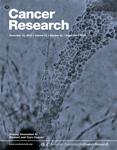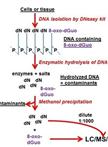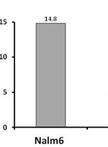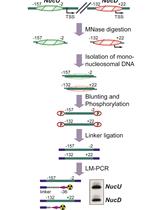- Submit a Protocol
- Receive Our Alerts
- Log in
- /
- Sign up
- My Bio Page
- Edit My Profile
- Change Password
- Log Out
- EN
- EN - English
- CN - 中文
- Protocols
- Articles and Issues
- For Authors
- About
- Become a Reviewer
- EN - English
- CN - 中文
- Home
- Protocols
- Articles and Issues
- For Authors
- About
- Become a Reviewer
Quantitative Methylation Specific PCR (qMSP)
Published: Vol 3, Iss 16, Aug 20, 2013 DOI: 10.21769/BioProtoc.871 Views: 36381
Reviewed by: Lin FangFanglian He
Abstract
Detection of low copies of methylated DNA targets in clinical specimens is challenging. The quantitative Methylation-Specific PCR (qMSP) assays were designed to specifically amplify bisulphite-converted methylated DNA target sequences in the presence of an excess of unmethylated counterpart sequences. These qMSP assays are real-time PCR assays utilizing, sequence-specific primers and an intervening, also sequence specific, Taqman probe to cover an amplicon of approximately 100 bp in length. The use of Taqman probes bearing a minor groove binding (MGB) allow for the use of shorter probes and therefore facilitate design and significantly increases the analytical specificity of the reaction. In the context of the biomarker discovery program of the Liverpool Lung Project (LLP), ten gene promoters were selected. qMSP assays were developed, validated and used to screen 655 bronchial washings from patients with lung cancer and age/sex matched controls with non malignant lung disease (Nikolaidis et al., 2012).
Materials and Reagents
- TaqMan® Universal Master Mix II no UNG (Life Technologies, catalog number: 4440039 )
- TaqMan MGB probes (custom synthesis) (Life Technologies)
- EZ DNA Methylation-GoldTM kit (ZymoResearch, catalog number: D5006 )
- The methylation-specific primer and probe sequences (see Recipes)
Equipment
- PCR cabinet
- PCR plates
- Centrifuge (Sigma-Aldrich)
- PCR thermal cycler (Life Technologies/Applied Biosystems, model: 9700 )
- Real time PCR machine (Life Technologies/Applied Biosystems, model: 7500 FAST )
Procedure
- Primer/probe design
Note: Primer/probe design is of major importance for the specificity of the reaction, i.e. to amplify only methylated bisulphite-converted target in the presence of excess unmethylated target. The primers should include 3-5 CG dinucleotides. The inclusion of at least two such CGs within the six 3’ end of the primer significantly increases specificity. This is in addition to the usual rules on primer stability, GC content and secondary structure avoidance apply in real time PCR assay design.
- One μg DNA was converted by sodium bisulphite using the EZ DNA Methylation-GoldTM kit and following the supplier’s protocol but eluting in 50 μl elution buffer (instead of the recommended 10 μl).
- The qMSP reactions contained 1x TaqMan® Universal Master Mix II non-UNG, 250 nM probe, 300-900 nM primers (Table 1) and 2 μl eluate from the bisulphite treated DNA sample.
Note: The primer concentration is an important determinant of analytical sensitivity/specificity and has to be ascertained experimentally In other words the analytical sensitivity threshold is set to the dilution that has an overlapping 95% Confidence Interval with the unmethylated control reaction. In practical terms, the highest sensitivity one can use is the one that is always at least 2 ΔCt. lower than the unmethylated control.
Table 1. Primer-probe concentrations for oligo mixes
Primer/probe mix
Final concentration (nM)
Fwd primer
Rev Primer
Probe
p16
700
700
250
TERT
250
250
250
RASSF1
700
700
250
TMEFF2
900
900
250
CYGB
300
300
250
RARb
500
500
250
DAPK1
250
250
250
p73
250
250
250
WT1
750
750
250
CDH13
250
250
250
ACTB
900
900
250
- PCR plates were sealed and span at 4,000 x g for 1 min prior to be placed in the thermal cycler in order to bring all the reaction volume to the bottom and ensure removal of bubbles from the reaction mix.
- The reactions were performed in duplicate on a 7500 FAST real time cycler under the following thermal profile: 95 °C for 10 min activation step followed by 50 cycles consisted of denaturation at 95 °C for 15 sec, annealing and extension at 58 °C–65 °C (Table 2, depending on the assay) for 1 min.
Table 2. Annealing information for qMSP optimised conditions
Genes
Annealing temp (°C)
Time (sec)
p16
60
60
RASSF1
60
60
CYGB
64
5
61
55
RARB
65
5
62
55
TERT
65
5
62.5
55
WT
62
60
ACTB
58
20
60
40
CDH13
64
5
61
55
DAPK
65
5
62.5
55
P73
65
5
62.5
55
TMEFF
58
20
60
40
Recipes
- The methylation-specific primer and probe sequences are listed in Table 3. In the initial steps of assay development it became apparent that probes bearing minor groove binding moiety (Taqman MGB probes) provided significantly higher assay specificity. In addition, due to their smaller size, they allow for a more flexible assay design.
Table 3. Nucleotide sequences of methylation specific primers and probes for the qMSP assays utilised in the BW screening. The ACTB assay is methylation-independent acting as DNA input control.
Primer/probe name
Sequence 5’ →3’
Modification
p16meth_F
GGAGGGGGTTTTTTCGTTAGTATC
p16meth_R
CTACCTACTCTCCCCCTCTCCG
p16meth_P
AACGCACGCGATCC
FAM-MGB
RASSF1meth_F
GTGGTGTTTTGCGGTCGTC
RASSF1meth_R
AACTAAACGCGCTCTCGCA
RASSF1_P
CGTTGTGGTCGTTCG
FAM-MGB
TMEFF2meth_F
GGAGAGTTAAGGCGTTTCGTAGTTC
TMEFF2meth_R
CGTGGGAAGAGGTAGTCGGG
TMEFF2meth_P
GTTTTTAGTTCGTTCG
FAM-MGB
TERTmeth_F
TTGGGAGTTCGGTTTGGTTTC
TERTmeth_R
CACCCTAAAAACGCGAACGA
TERTmeth_P
AGCGTAGTTGTTTCGG
FAM-MGB
CYGBmeth_F
GTGTAATTTCGTCGTGGTTTGC
CYGBmeth_R
CCGACAAAATAAAAACTACGCG
CYGBmeth_P
TGGGCGGGCGGTAG
FAM-MGB
RARbmeth_F
GATTGGGATGTCGAGAACGC
RARbmeth_R
ACTTACAAAAAACCTTCCGAATACG
RARbmeth_P
AGCGATTCGAGTAGGGT
FAM-MGB
DAPK1meth_F
CGAGCGTCGCGTAGAATTC
DAPK1meth_R
ACCCTACAAACGAACTAACGACG
DAPK1meth_P
AGCGTCGGTTTGGTAG
FAM-MGB
p73meth_F
TTGTTTTTTGGATTTTAAGCGTTTC
p73meth_R
CACCCGAATCTCTCCTAACCG
p73meth_P
TAACGCTAAACTCCTCG
FAM-MGB
WT1meth_F
GAGGAGTTAGGAGGTTCGGTC
WT1meth_R
CACCCCAACTACGAAAACG
WT1meth_P
AGTTCGGTTAGGTAGC
FAM-MGB
CDH13meth_F
CGTGTATGAATGAAAACGTCGTC
CDH13meth_R
CACAAAACGAACGAAATTCTCG
CDH13meth_P
CGTTTTTAGTCGGATAAAA
FAM-MGB
ACTBmgb_F
GGGTGGTGATGGAGGAGGTT
ACTBmgb_R
TAACCACCACCCAACACACAAT
ACTBmgb_P
TGGATTGTGAATTTGTGTTTG
VIC-MGB
Cycle threshold (Ct) values for each target were normalized for DNA input by calculating the ΔCt=Ct(Target)-Ct(ACTB). The values for al samples were transformed to relative quantity (RQ) compare to the calibrator (0.5% standard methylated DNA dilution) included in all experiments using the following type:
RQsample = 2-ΔΔCt, whereΔΔCt = ΔCtsample - ΔCtcalibrator.
Note: qMSP is a challenging version of real-time PCR and one needs to gain a very good understanding of the latter prior to engaging in qMSP experiments. The main additional challenge is the use of bisulphite DNA which is of lower quality but most importantly of lower complexity. This significantly affects the thermodynamic behavior of this template in the reaction. The authors are very happy to provide assistance to colleagues if needed; please email Dr. T Liloglou (tliloglo@liv.ac.uk).
Acknowledgments
This protocol is adapted from Nikolaidis et al. (2012).
References
- Liloglou, T., Bediaga, N. G., Brown, B. R., Field, J. K. and Davies, M. P. (2012). Epigenetic biomarkers in lung cancer. Cancer Lett 342(2): 200-212.
- Nikolaidis, G., Raji, O. Y., Markopoulou, S., Gosney, J. R., Bryan, J., Warburton, C., Walshaw, M., Sheard, J., Field, J. K. and Liloglou, T. (2012). DNA methylation biomarkers offer improved diagnostic efficiency in lung cancer. Cancer Res 72(22): 5692-5701.
Article Information
Copyright
© 2013 The Authors; exclusive licensee Bio-protocol LLC.
How to cite
Liloglou, T. and Nikolaidis, G. (2013). Quantitative Methylation Specific PCR (qMSP). Bio-protocol 3(16): e871. DOI: 10.21769/BioProtoc.871.
Category
Cancer Biology > General technique > Biochemical assays > DNA structure and alterations
Systems Biology > Epigenomics > DNA methylation
Molecular Biology > DNA > PCR
Do you have any questions about this protocol?
Post your question to gather feedback from the community. We will also invite the authors of this article to respond.
Share
Bluesky
X
Copy link













